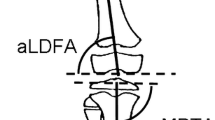Summary
Longitudinal growth determined by roentgen stereophotogrammerry was registered in three patients with physial injuries in distal femur and in two patients with physial injuries in proximal tibia during 18 months. The injuries in distal femur were classified as Type I, Type I + III and Type IV and in proximal tibia as Type I + III and Type IV in the different cases according to Salter and Harris. Markers of tantalum balls were implanted into the metaphysis and bony epiphysis of distal femur and proximal tibia permitting regular determination of longitudinal growth.
Significant growth disturbances was registered in four patients. The Salter-Harris classification was difficult to use to predict growth disturbance after physial injuries around the knee.
The roentgen stereophotogrammetric method was found useful to determine normal growth rate and after physial injuries to reveal growth disturbance leading to complete or partial growth arrest resulting in leg length discrepancy or angular deformity. This method facilitates preoperative planning if surgery is needed.
Zusammenfassung
Über 18 Monate wurde mit Hilfe der Röntgenstereophotogrammetrie das Längenwachstum geschädigter Wachstumsfugen am distalen Femur (3 Fälle) sowie der proximalen Tibia (2 Fälle) verfolgt. Dabei handelte es sich am Femur um Schädigungstypen I, I + III und IV (nach Salter/Harris), an der Tibia um die Typen I + III und IV.
Um eine exakte Messung des Längenwachstums durchführen zu können, wurden Tantalkugeln als „Markören” sowohl in die Metaphyse als auch in die Epiphyse des distalen Femurs und der proximalen und distalen Tibia eingebracht. In vier Fällen waren signifikante Wachstumsstorungen zu registrieren, ohne daß aufgrund der Salter-Harris-Einteilung zu-vor eine abartige Wachstumsstörung zu erwarten gewesen wäre. - Die Röntgenstereophotogrammetrie kann somit nicht nur als Methode zur Bestimmung des normalen Wachstums angesehen werden, sondern ist gleichfalls geeignet, Wachstumsstorungen bei traumatisch bedingten Fugenschädigungen aufzuzeigen.
Similar content being viewed by others
References
Aitken AP, Magill HK (1952) Fractures involving the distal femoral epiphyseal cartilage. J Bone Jt Surg 34-A:96–108
Aitken AP (1965) Fractures of the epiphysis. Clin Orthop 41:19–23
Aronson AS, Holst L., Selvik G (1974) An instrument for insertion of radioopaque bone markers. Radiology 113:733–734
Aronson AS, Jonsson N (1974) Tissue reactions to tantalum markers for X-ray studies. In: X-ray stereophotogrammetry of longitudinal bone growth. Thesis, Lund
Aronson AS (1976) X-ray stereophotogrammetry of longitudinal bone growth. Thesis, Lund
Basset FH, Goldner LJ (1962) Fractures involving the distal femoral epiphyseal growth line. South Med Journal 55:545–556
Bergenfeldt E (1933) Beiträge zur Kenntnis der traumatischen Epiphysenlösungen an den langen Röhrenknochen. Acta Chir Scan Suppl 28:73:1–422
Björk A (1968) The use of metallic implants in the study of facial growth in children: Method and application. Am J Phys Anthropol 29:243
Burkhart SS, Peterson HA (1979) Fractures of the proximal tibia epiphysis. J Bone Jt Surg 61-A:996–1002
Cassebaum WH, Patterson AH (1965) Fractures of the distal femoral epiphysis. Clin Orthop 41:79–91
Crawford AH (1976) Fractures about the knee in children. Orthop Clin N Am 7:639–656
Ehrlich MG, Strain RE (1979) Epiphyseal injuries about the knee. Orthop Clin N Am 10:91–103
Langenskiöld A (1967) The possibilities of eliminating premature closure of an epiphysial plate caused by trauma or disease. Acte Orthop Scand 38:267–279
Langenskiöld A (1975) An operation for partial closure of an epiphysial plate in children, and its experimental basis. J Bone Jt Surg 57-B:325–330
Lombardo SJ, Harvey PJ (1977) Fractures of the distal femoral epiphysis. J Bone Jt Surg 59-A:742–751
Österman K (1972) Operative elimination of partial premature epiphyseal closure. Acta Orthop Scand Suppl 147
Poland J (1898) Traumatic separation of epiphysis. Smith Elder and Co., London
Salter RB, Harris RW (1963) Injuries involving the epiphyseal plate. J Bone Jt Surg 45-A:587–621
Salter RB (1979) Epiphyseal plate injuries in the adolescent knee in the injured adolescent knee. Kennedy JC (ed) The Williams and Wilkings Comp., Baltimore, pp 77–101
Selvik G (1974) A roentgen stereophotogrammatic method for the study of the kinematics of the skeletal system. Thesis, Lund
Stephens DC, Lois DS (1974) Traumatic separation of the distal femoral epiphyseal cartilage plate. J Bone Jt Surg 56-A:1383–1390
Tachdijan MD (1972) Pediatric orthopaedics. W. B. Saunders, Philadelphia
Author information
Authors and Affiliations
Rights and permissions
About this article
Cite this article
Bylander, B., Aronson, S., Egund, N. et al. Growth disturbance after physial injury of distal femur and proximal tibia studied by roentgen stereophotogrammetry. Arch. Orth. Traum. Surg. 98, 225–235 (1981). https://doi.org/10.1007/BF00632981
Received:
Issue Date:
DOI: https://doi.org/10.1007/BF00632981




